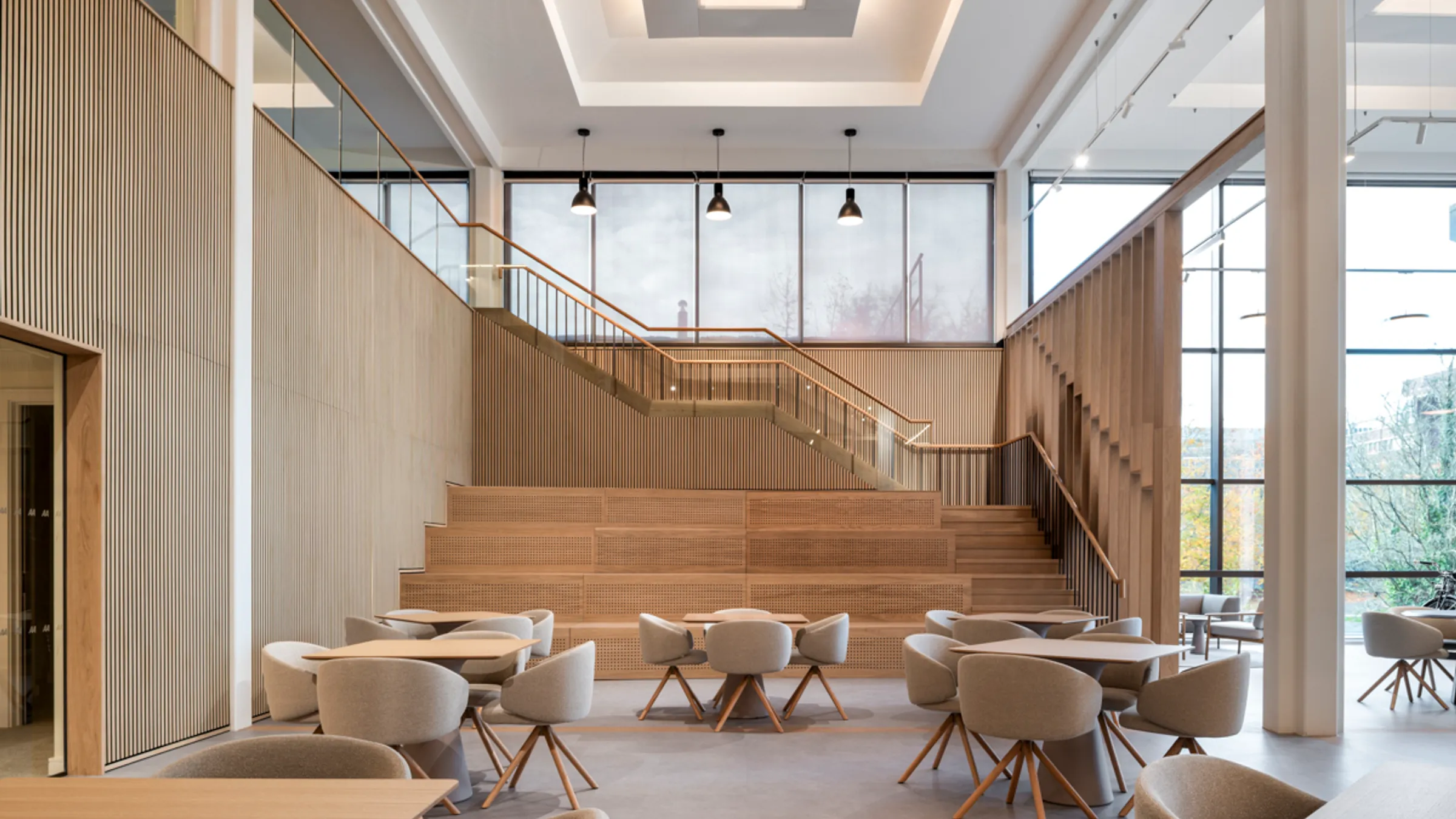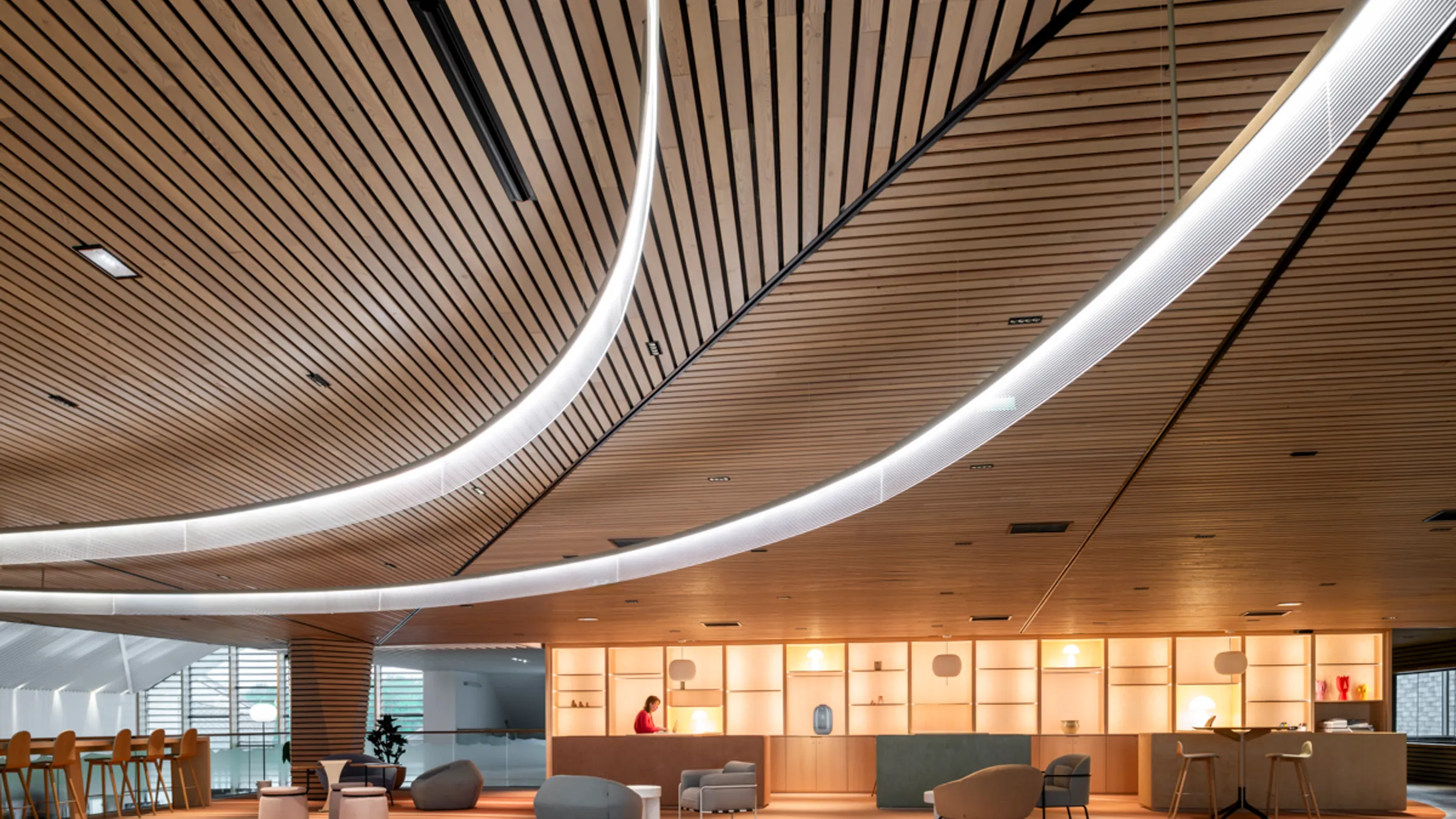How to Design a Neuroinclusive Workplace.


Written by
Gareth Van Zyl
Contents
What Does Neurodiversity Mean in the Workplace?
Neurodiversity refers to the natural variation in how people experience, process, and interact with the world. In a workplace, it includes employees with conditions such as:
Autism Spectrum Disorder (ASD)
Attention Deficit Hyperactivity Disorder (ADHD)
Dyslexia and other learning differences
Sensory Processing Disorder (SPD)
Creating inclusive environments means designing workplaces where all employees feel comfortable, supported, and empowered to thrive, regardless of how they process information or experience stimuli.
Why the Physical Environment Matters for Neuroinclusive Design
Not only does the physical environment of a workspace affect everyone, with the workplace design being a key factor in productivity, but workspaces can feel overwhelming for lots of people, which is why it is even more important to keep certain things in mind when designing a workspace.
From noise levels to lighting, layout to furniture, every design element in a workplace affects how neurodivergent individuals feel, focus, and perform. Inclusive design considers sensory processing, executive function, spatial memory, and emotional regulation, not just aesthetics or trends. There are many factors affecting and influencing workplace design choices so making sure where you are designing is going to be right for everyone is essential.
This goes beyond ergonomic chairs; it includes how spaces sound, look, feel, and flow. The right setup reduces anxiety, enables self-regulation, and supports autonomy.

Why Office Furniture Matters for Creating a Neuroinclusive Environment?
Office furniture has a direct impact on how neurodiverse individuals experience the workplace. The psychology behind workplace design is very important, with colours, spacing and natural elements all affecting mental health. This makes it essential to understand why you need a neuroinclusive workspace, as lots of people who are neurodiverse have a different way of filtering outside stimuli, resulting in being overloaded by things that people who are neurotypical would not be.
Here’s why:
Sensory Sensitivity and Overstimulation:
Many neurodivergent people are more sensitive to noise, visual distractions, or bright lights. In open-plan offices, where sounds echo, lighting is harsh, and movement is constant, this can lead to sensory overload, anxiety, or burnout. Furniture that helps buffer or segment space, such as acoustic panels, modular dividers, or high-backed chairs, can make a significant difference by reducing the intensity of these stimuli.
Control and Choice:
One size doesn’t fit all. Providing a range of furniture options, such as adjustable desks, quiet pods, soft seating areas, or collaborative zones, allows individuals to choose a setting that matches their current sensory and cognitive needs. Creating an agile workspace helps people choose where they work best. This flexibility gives people more agency over how and where they work, helping them to self-regulate energy levels, maintain focus, and feel more at ease.
Comfort, Posture, and Privacy:
Ergonomic seating and furniture are essential not just for physical health but for mental well-being. Poor posture can contribute to restlessness and difficulty concentrating, which is particularly challenging for those with ADHD or other attention-related differences. Furniture that supports good posture, offers privacy, and reduces physical discomfort helps create a calmer and more supportive environment. Quiet zones, sit-stand desks, and semi-enclosed seating can all contribute to greater comfort and reduced distraction.

8 Key Ways You Can Support Neurodiverse Employees with Office Design
We know that truly inclusive workspaces go beyond compliance, they’re intentionally designed to support different ways of thinking, working, and interacting. Here are eight practical, design-led ways we can help create a neuroinclusive workplace.
1. Flexible Workstations and Workspaces
Workstyles vary from person to person, and neurodiverse employees often benefit from the ability to adapt their environment throughout the day. Flexible workstations make this possible, supporting changes in posture, location, and sensory input.
Sit–stand desks encourage movement, helping to regulate energy levels and improve focus.
Mobile desks allow individuals to relocate based on comfort, proximity to others, or sensory needs.
Modular setups create adaptable layouts that shift from quiet, focused zones to collaborative spaces as required.
Integrate movement-enabled furniture such as rocking chairs, balance stools, and standing mats to encourage gentle motion for sensory regulation,
2. Zoned Seating for Autonomy and Focus
Dynamic, well-defined zones give employees more control over how they engage with their work, particularly important for those who require different environments for different tasks.
High-backed booths, open lounge seating, and semi-private nooks clearly separate spaces.
Offering both collaborative areas and quiet work settings lets employees choose an environment that suits them in the moment.
Designing predictable, symmetrical layouts will help make navigation easier and reduce visual overwhelm.
3. Spaces for ‘Body Doubling’
Some neurodivergent employees benefit from body doubling, working alongside others to boost focus and motivation.
Creating areas with paired desks, shared focus tables, and low-stimulation collaboration pods to facilitate this.
These can be integrated alongside quiet zones, giving staff choice between independent and partnered work styles.
4. Soft Seating and Retreat Furniture
Sometimes, supporting productivity means creating space for decompression.
Soft seating such as bean bags, privacy chairs, and high-sided armchairs creates comfort and a sense of enclosure.
Retreat seating placed in low-stimulus areas gives employees an escape from busy, high-traffic spaces.
Adding stimming-friendly features like tactile armrests, textured wall panels, and fidget-friendly side tables to normalise and support self-regulation.

5. Acoustic Furniture
Noise is one of the most common workplace stressors for neurodiverse individuals, particularly in open-plan settings.
Upholstered panels, acoustic booths, and felt-wrapped partitions absorb sound while maintaining an open feel.
Sound-buffering furniture can help define zones without major structural changes, reducing noise bleed between areas.
6. Personalised Furniture Adjustments
Not all comfort solutions are one-size-fits-all. We help organisations offer employees the ability to customise their workstations to their own sensory and ergonomic needs.
Adjustable lumbar support, adaptable armrests, and even weighted lap cushions can aid posture and sensory regulation.
Employees can choose the desk, seating, and accessory options that work best for them.
7. Design for Clutter-Free Focus
Visual clutter can be distracting and mentally taxing. We integrate storage and workspace organisation into our designs to help maintain focus. Tech integration, with the introduction of cables and other unavoidable parts of tech, can sometimes have other issues that need to be addressed.
Built-in storage, cable management solutions, and modular shelving keep work surfaces clear.
Concealed joinery and discreet storage zones create a visually calm, low-distraction environment.
8. Environmental and Sensory Layering
Beyond furniture, the surrounding environment plays a huge role in inclusion. We combine multiple sensory considerations into each fit-out:
Lighting: Tunable colour temperature, circadian lighting, and non-flickering LEDs reduce visual overstimulation.
Acoustics: Layered solutions including soundscaping, acoustic ceilings, and furniture-based sound absorption.
Materials & Air Quality: Low-VOC finishes, scent-controlled zones, and natural materials like wood, wool, cork, and stone for grounding calm.
Wayfinding: Clear, colour-coded zoning and consistent contrast help with navigation for those with ADHD or dyslexia.
Zoning & Transitions: Buffer spaces and biophilic elements create smooth sensory transitions between task types and help reduce stress.
When thoughtfully integrated, these eight strategies do more than make a workplace look good, they actively promote inclusion, comfort, and productivity. At Sketch Studios, we design, source, and deliver these solutions as part of a holistic, neuroinclusive workplace strategy.
When thinking about Neurodiversity in the workplace, it is important to remember that the physical aspect is not the only thing to consider. Making sure to implement ways to help with Dyslexia and frustrations that come with learning based difficulties, like ADHD. Specific tech integrations and training can help develop a wholesale, inclusive workspace.

FAQs
How do you make a workplace that is neuroinclusive?
A neurodivergent-friendly workplace is one that’s intentionally designed to support different ways of thinking, processing, and working. Key principles include:
Offer flexibility and choice – Provide adjustable desks, mobile workstations, quiet pods, and collaborative zones so employees can choose environments that match their sensory and cognitive needs.
Create clear zones – Use high-backed booths, semi-private nooks, and predictable layouts to give people control over focus and interaction levels.
Support different working styles – Include spaces for independent work, “body doubling” (working alongside others for motivation), and low-stimulation retreat areas.
Prioritise sensory comfort – Incorporate acoustic furniture, soft seating, tactile surfaces, and clutter-free storage to reduce overstimulation.
Layer environmental elements – Use tunable lighting, sound absorption, low-VOC materials, and clear wayfinding to make spaces easier to navigate and more comfortable.
Allow personalisation – Enable employees to adjust furniture and accessories for ergonomic and sensory preferences.
Done well, these strategies reduce anxiety, improve focus, and promote inclusion, making the workplace better for everyone, not just neurodivergent employees
What types of office furniture are best for neurodiverse employees?
Furniture that is flexible, adjustable, and sensory-considerate, such as sit-stand desks, acoustic pods, and soft seating.
How can furniture help reduce anxiety or overstimulation at work?
By offering choice, acoustic shielding, personal space, and sensory-friendly materials, furniture can help individuals manage input and stress levels.
Is neurodiverse-friendly furniture more expensive?
Not necessarily. Many inclusive options are scalable or modular. Investing in flexibility early reduces retrofitting costs and improves long-term well-being.
Need help designing an office that supports neurodiversity? Contact Sketch Studios here.
Designing for neuroinclusion benefits everyone. When employees have the right tools and spaces to manage their environment, they unlock better productivity, stronger wellbeing, and improved talent retention.
Published on
November 11, 2025























